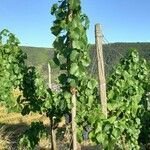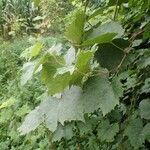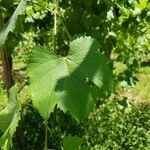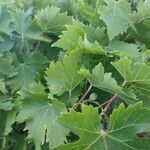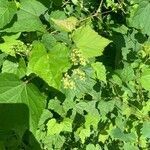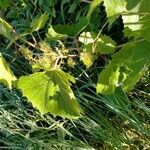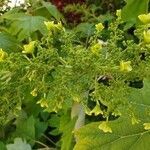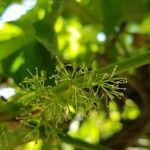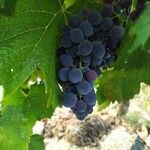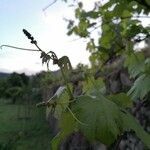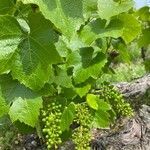Plants sprawling to moderately high climbing, sparsely branched. Branches: bark exfoliating in shreds or plates; nodal diaphragms 3–5 mm thick; branchlets terete to slightly angled, pubescent, sometimes glabrescent, growing tips not enveloped by unfolding leaves; tendrils along length of branchlets, persistent, tendrils (or inflorescences) at only 2 consecutive nodes; nodes not red-banded. Leaves: stipules usually more than 3.5 mm; petiole ± equaling blade; blade cordate-ovate to cordate-orbiculate, 12–20 cm, usually 3-shouldered to 3–5-lobed, sometimes deeply so, apex acute to short acuminate, abaxial surface not glaucous, sparsely pubescent to glabrate, visible through hairs, adaxial surface usually glabrous. Inflorescences 10–20 cm. Flowers bisexual. Berries usually reddish purple to nearly black, sometimes yellow-green, ± glaucous, oblong to ellipsoid, 8–25 mm diam., skin adhering to pulp; lenticels absent. 2n = 38, 76.
A woody vine which keeps growing from year to year. It is often pruned to reduce its size. It climbs by coiled tendrils which attach to objects. It has large leaves which are roughly heart shaped. They can be entire or be deeply divided into 3-5 lobes. Leaves can be 20 cm across. The edges of the leaf are sharply and irregularly toothed. The tip of the leaf is pointed and the base is rounded. Sometimes the leaves are hairy. The flowers are small and yellow-green. They occur in clusters which are 5-20 cm long and beside the leaves. The 5 green petals drop off together to show 5 central stamens and the ovary. These bear clusters of fleshy fruit. The fruit is a berry which is generally oval and juicy. The skin can be yellow or violet-black. They are 1-4 cm long. The flesh is edible. They contain a few hard seeds. There are 10,000 cultivated varieties.
Vigorous liane; tendrils usually forked, intermittently present at nodes. Young shoots and lvs greyish white with floccose tomentum, sometimes pale brown. Petiole usually < lamina. Lamina of mature lvs to c. 17 × 18 cm (larger in cultivation), broad-ovate, 3-or 5-lobed to varying degrees, glabrous to whitish or pale greyish tomentose below, coarsely serrate; basal sinus usually deep and narrow with lobes tending to overlap but sometimes lobes forming a wide, rounded sinus. Fls fragrant, green, in dense elongated panicles replacing tendrils in the upper shoot axils. Calyx truncate, 0.2-0.5 mm long. Corolla 1.5-2.5 mm long; lobes valvate and lightly cohering towards apex. Filaments < or > corolla. Berry ± globular, (0.5)-0.7-1.5-(2.3) cm diam., black with some glaucous bloom; flesh sweet.

